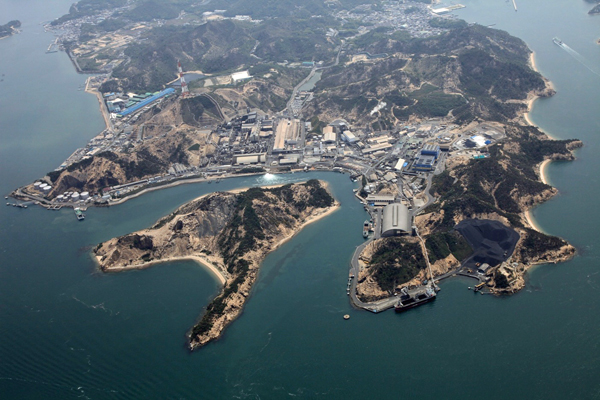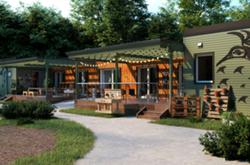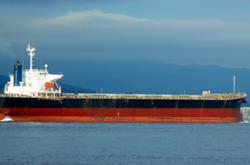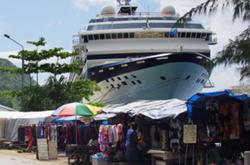[Editor's note: Every day this week we're featuring reports from Christopher Pollon's quest to follow a pound of B.C. copper from cradle to grave -- and back again. Today's story dives into the surreal island of Naoshima in Japan where copper from Princeton, B.C. gets refined. To get a sense of the scope of the project, see this interactive map and introductory story.]
From the deck of a private ferry racing across the Seto inland sea, Naoshima Island appears as a tower of yellow rock on the horizon, tipped in a lush emerald. As we approach, blue-uniformed figures appear, darting in tiny vehicles around an imposing industrial complex bearing the red insignia of Mitsubishi, one of the world's most powerful corporate conglomerates.
If this were a James Bond movie, Naoshima would be the island lair of an arch-villain. Instead it's home to one of Japan's oldest operating copper smelters, in almost continuous use since 1917. It's also the first destination for the raw copper produced at the Copper Mountain mine near Princeton, and much of the rest of the copper mined today in British Columbia.
I came expecting Mordor, only to find the world's oddest fine art display, with a 230-metre smokestack rising from the northern tip. In a surreal twist that is uniquely Japanese, Naoshima is also a world famous art gallery "park," covering most of the island's 17 square-kilometres. It's home to three major art galleries featuring works by Pollock, Warhol and Monet. Random sculptures dot the shoreline. The island's narrow roads navigate a maze of buildings and villages in traditional Japanese style, transformed into stunning, often bizarre, fine art installations.
Nonetheless, this is also one of the world's most important centres for smelting and refining the pure metal out of copper ore from mines around the globe. After China, Japan smelts more copper than anywhere else on the planet (about 10 per cent of the global total), and Naoshima is one of four Japanese copper smelters in the world's top 20 list of producers of refined copper by volume.
Princeton to Naoshima
Raw copper concentrate -- a fine black powder containing roughly 30 per cent pure metal -- leaves Copper Mountain by truck to be driven 300 kilometres to tidewater at the Port of Vancouver's Vancouver Wharves. There it's loaded onto "Handymax" bulk carrier ships, alongside raw copper from two other B.C. mines -- Huckleberry near Smithers B.C., and Teck's Highland Valley southwest of Kamloops. (Mitsubishi Materials and two other Japanese companies own half of Huckleberry, and MMC has a continuing purchase contract with Highland Valley). Once a month the ships leave with 12,000 tonnes of Copper Mountain concentrate for the two-week sea voyage to Naoshima.
Commodities such as copper concentrates and coal are often shipped to the world on what's called a "freight on board" basis -- meaning the customer takes ownership of the product the moment it's loaded on the ship.
From this point forward, where most B.C. resources go can become hard to trace. Call it primary producer resource myopia. Take for example, a recent shipment of B.C. coal from Vancouver that reached Finland through the seasonally ice-free Northwest Passage this past September. The company that mined the coal, Vancouver's Teck, did not monitor or know the route the coal took once it was in the ship's hold. Copper Mountain's output proved easier to follow.
Into the melting pot
The raw concentrate is unloaded at a Naoshima dock, dried, mixed with ore from other mines, and moved by conveyor belt to the first of three furnaces to be "fire-refined." The "Mitsubishi Process" of smelting gradually removes the impurities inherent to the ore -- mostly sulphur and iron. At the end of the process, plates of 99.999 per cent pure copper emerge: the basic material of wire, pipe, and everything else the versatile red metal will become.
Looking inside the primary furnace is like peering into the mouth of a volcano. A storm of molten raw copper lava glows fluorescent orange, as concentrate from Copper Mountain melds into copper from the Batu Nhijau mine in Indonesia, and Los Pelambras and Escondida in Chile. Copper contained in shredded circuit boards from electronics ("e-waste") also goes in now; cleaner recycled copper wire will be added later.
Oxygen is pumped into the primary furnace, causing much of the sulphur, iron and e-waste plastic to burn off (see sidebar). The process releases immense amounts of heat, which is captured and used to supply one-quarter of the smelter's energy needs. The rest is provided by a combination of coal and natural gas -- two other commodities Japan needs from B.C.
Copper Mountain sends one shipment of ore per month to Naoshima, and receives 90 per cent of its estimated value on loading aboard ship at the Vancouver Wharfs. The balance is paid after a series of price adjustments, including credit for the silver and gold also extracted from the concentrate. In 2012, Copper Mountain's first full year of production, the gold and silver purified here accounted for almost 20 per cent of its total revenue.
The Japanese way
Over the three days I spent touring the Naoshima smelter and two copper manufacturing plants in Osaka, Satoshi Kikuchi seldom left my side. The 28-year-old assigned as my "handler" had spent most of his time with the Mitsubishi division that sources copper concentrate from across the world.
Kikuchi speaks excellent English and was genuinely friendly, although it was never entirely clear whether his assignment as escort during my research was a perk or a punishment. Like virtually all Japanese men of working age, he wears navy blue dress plants with a crisply pressed white collared shirt. "It's just the uniform," he says in a slightly fatigued voice when I press him about why so-called "salary men" all dress the same.
But the conformity is telling. North Americans, particularly in private sector businesses, prize the independent entrepreneurial spirit, the individual who by virtue of personal talent can rise above the pack. In Japan, it's all about respecting consensus and rank -- conforming to the path laid out by one's superiors.
The defining national cultural trait came to the Naoshima smelter's rescue in 2004. A fire swept Naoshima island that year. The smelter's employees did not evacuate; instead they mobilized into fire-fighting brigades, and fought to save the facility (and precious artworks) from destruction.
Offspring of the 'zaibatsu'
Japan's rise since the 19th century into an industrialized nation has been led by resource-hungry conglomerates like Mitsubishi, who in turn have relied on a steady supply of copper and other resources from places like Canada. Copper has tied that history to B.C.'s own for nearly as long. From early on, the copper mined from the Similkameen Valley near Princeton was destined for Japan.
Mitsubishi began life in the 1870s, one of Japan's original "zaibatsu" -- closely-knit pyramids of related companies that were born when the Japanese government conducted the world's first mass privatization, transferring formerly state-run-businesses to wealthy families. Through their many arms, these zaibatsu reached into most areas of the economy, with different branches subsidizing their partner firms. Under a succession of family leaders, Mitsubishi diversified from shipping and mining into banking, real estate and many areas of manufacturing, eventually including warships and aircraft (the brutally effective Zero fighter plane of the Second World War was a Mitsubishi innovation).
The war, which broke out first in Europe to contain German aggression, initially faced B.C. with a dilemma: mining operations near Princeton continued to export ore to Japan -- a German ally. As historian John Goodfellow recounts, the shipments divided citizens. Local church groups protested against the exports. A July 18, 1940, Princeton Star editorial defended them, noting that millions had been invested in mine improvements to facilitate the trade, and that both the Canadian and British governments knew they were taking place. The attack on Pearl Harbour settled the matter: exports to Japan ceased.
Japan's post-war American military governors dismantled the "zaibatsu," by then centres of immense power and privilege, in a restructuring designed to reduce their influence. "Dismantling of zaibatsu by the Allied Forces was a total success," says Masao Nakamura, an Asian business expert at UBC's Sauder School of Business. "All zaibatsu families like Mitsubishi/Iwasaki, Sumitomo and Mitsui, pretty much lost all of their assets and the family lines as business empires were terminated forever."
The Mitsubishi companies became publicly-traded business ventures, and exist today as a network of loosely connected corporations, without a core controlling company or owner as they had before the war. Still, these company groups remain an omnipresent force in the lives of Japanese many years later. Nikon, Kirin beer, Mitsubishi automobiles and Asahi, the world's biggest glass maker, all exist under this loose Mitsubishi banner.
Controlling the value chain
B.C. copper can stay within the extended Mitsubishi group of companies almost from mountain pit to packaged consumer good. MMC owns portions of two B.C. copper mines, with contracts to buy from a third (Highland Valley copper, near Kamloops); it also runs three copper smelters. MMC and other Mitsubishi companies take the refined copper they produce and add value to it in a variety of ways, with more than half the metal they refine remaining "in the family" on its path to finished products.
Every month, about 20 tonnes of Naoshima copper is shipped to MMC's Sakai plant in Osaka, where it is transformed into giant copper bars, cylinders and specialty copper products such as alloys and anode copper balls -- the latter used in manufacturing the printed circuit boards in electronics and smartphones.
Hideya Sato, general manager of the Sakai plant, says the future and profitability of his industry in Japan lies in the creation of specialized products like those anode balls, durable trolley wire for high speed rail, or hair-like, super-fine alloy wire for use in aerospace, robotics, and new-generation automobile wiring.
"In Japan, labour and energy costs are high, so many industries have gone overseas," says Sato. But while demand from Japan's own manufacturers is generally in decline, value-added copper products remain a profitable niche.
Place is important
When it's all over, my handler Kikuchi and I ride the Nazomi "Super Express" bullet train from Osaka into Tokyo. The latest high-speed trains contain anywhere from two to four tonnes of copper, twice the content of conventional electric trains. Along the way, I express my amazement at how this island nation of 125 million rose to be an industrial power with virtually no resources of its own.
Kikuchi politely corrects me: there is a single Japanese gold mine operating. It's called Hishikari, and is located in the northern part of Kagoshima Prefecture -- the country's last remaining commercial metal mine.
I'm intrigued by the finality of Hishikari. It reinforces something that's become increasingly clear as I've followed B.C. copper around the world: the patch of earth a mineral is drawn from, and where it goes in the world, are important.
The patch of tundra where Alaska's Pebble mine plans to unearth 72 billion pounds of copper, is of specific importance to commercial fishermen downstream at Cook Inlet. Diamonds mined in the war-free Canadian Arctic earn a premium based on where they are found.
Then there's Clogau -- an old mine in Wales, historically used to provide the metal for wedding bands for British royalty, that in recent years has marketed jewellery made from its last flagging seam as "the gold of royalty," and as ancient "Welsh gold."
So why wouldn't Japanese consumers, noted for their strong national pride, be willing to pay more for jewellery crafted from the very last trickle of gold from all of Japan?
Kikuchi blushes, confused by my question.
"No," he says finally. "Gold is gold." ![]()
Read more: Energy, Labour + Industry


















Tyee Commenting Guidelines
Comments that violate guidelines risk being deleted, and violations may result in a temporary or permanent user ban. Maintain the spirit of good conversation to stay in the discussion.
*Please note The Tyee is not a forum for spreading misinformation about COVID-19, denying its existence or minimizing its risk to public health.
Do:
Do not: